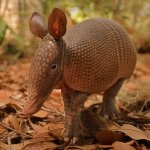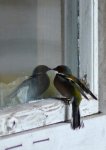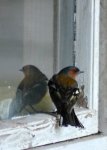(Also written in The Cheesiest Thread in the World.)
In one of my "basic" behavioral psychology classes, we each were assigned a white lab rat with red eyes and a body that was about 2/3 the length of my forearm, with a long pink tail that hung off my wrist.
I was MORTIFIED the first day of class. The instructor was like, "Ok, go get your rat," and I FROZE.
I called the little guy Squeak because I must have squeezed him a little too hard out of sheer anxiety, and the poor little thing let out a few squeaks to save his life.
After that, I brought in a pair of rubber gloves -- I was the only student to do so; yes, I'm a big chicken -- but at least I found it bearable.
And I must have loosened up my grip, because I never heard Squeak squeak again in my presence.
@Tazzo asked some questions about this:
The class was mandatory for my undergrad degree, which was Behavioral Psychology. At the graduate level, they use pigeons.
In this class, you worked with a rat in a Skinner Box (named after the guy who came up with it):
View attachment 274790
I am seeing horrifying pictures of Skinner boxes on the internet with electrified shock floors -- PLEASE NOTE THAT OUR BOXES DID NOT HAVE THIS, and the rats were NOT shocked or harmed in any way.
The purpose is to learn about the effect of reinforcement and how it shapes behavior. The rats are water-deprived for 24 hours (which has been claimed does not hurt them), and you have control of an outside lever that sends a dipper through the box with a drink of water (box designs vary, this was similar but not exact to the ones we used.)
The rat eventually learns that if it does certain things, it will get a drink of water. At the end of the class, you have to show that you have reinforced your rat into doing a string of something like 5 behaviors before getting a drink of water.
For instance, my demonstration was something like Squeak having to wait for the ring of a bell, pull a chain, turn in a circle, wait for a light to come on, then press a lever in the box -- and then he got his drink of water.
Everyone asked me how I got him to turn in a circle. I had noticed in our sessions, Squeak would just do this naturally, and I started giving him drinks of water. Pretty soon, the poor little guy was twirling himself dizzy trying to get those drinks! This is the exact same thing they do at SeaWorld -- all the leaps, jumps, and twirls are natural behaviors that have been shaped through reinforcement.
Why bother studying this?
A very simple case study was of a young girl who had a persistent cough with no known medical origin or solution. It was eventually found that the cough was bringing her a plethora of attention from everyone around her. Once this was under control and the excessive attention stopped, so did the coughing.
This was just a very basic case of basic principles -- but you can see how and why science is trying to apply this to human behaviors.
In one of my "basic" behavioral psychology classes, we each were assigned a white lab rat with red eyes and a body that was about 2/3 the length of my forearm, with a long pink tail that hung off my wrist.
I was MORTIFIED the first day of class. The instructor was like, "Ok, go get your rat," and I FROZE.
I called the little guy Squeak because I must have squeezed him a little too hard out of sheer anxiety, and the poor little thing let out a few squeaks to save his life.
After that, I brought in a pair of rubber gloves -- I was the only student to do so; yes, I'm a big chicken -- but at least I found it bearable.
And I must have loosened up my grip, because I never heard Squeak squeak again in my presence.
@Tazzo asked some questions about this:
The class was mandatory for my undergrad degree, which was Behavioral Psychology. At the graduate level, they use pigeons.
In this class, you worked with a rat in a Skinner Box (named after the guy who came up with it):
View attachment 274790
I am seeing horrifying pictures of Skinner boxes on the internet with electrified shock floors -- PLEASE NOTE THAT OUR BOXES DID NOT HAVE THIS, and the rats were NOT shocked or harmed in any way.
The purpose is to learn about the effect of reinforcement and how it shapes behavior. The rats are water-deprived for 24 hours (which has been claimed does not hurt them), and you have control of an outside lever that sends a dipper through the box with a drink of water (box designs vary, this was similar but not exact to the ones we used.)
The rat eventually learns that if it does certain things, it will get a drink of water. At the end of the class, you have to show that you have reinforced your rat into doing a string of something like 5 behaviors before getting a drink of water.
For instance, my demonstration was something like Squeak having to wait for the ring of a bell, pull a chain, turn in a circle, wait for a light to come on, then press a lever in the box -- and then he got his drink of water.
Everyone asked me how I got him to turn in a circle. I had noticed in our sessions, Squeak would just do this naturally, and I started giving him drinks of water. Pretty soon, the poor little guy was twirling himself dizzy trying to get those drinks! This is the exact same thing they do at SeaWorld -- all the leaps, jumps, and twirls are natural behaviors that have been shaped through reinforcement.
Why bother studying this?
A very simple case study was of a young girl who had a persistent cough with no known medical origin or solution. It was eventually found that the cough was bringing her a plethora of attention from everyone around her. Once this was under control and the excessive attention stopped, so did the coughing.
This was just a very basic case of basic principles -- but you can see how and why science is trying to apply this to human behaviors.
Interesting study you had, about behaviour.
Like Squeak, my dog also learned, unfortunately, to beg by pressing her muzzle on my leg.. She started doing that herself but she just looked too cute not to give her something as a reward for it. She might have trained me instead..
My stories includes mice as usual
When I got my driving licence, I used to drive my dad's Nissan Sunny. Once I backed it out of the carage and then saw something on the rearview mirror. There was mouse jumping on the hat rack (?? We call it hat rack.. what an earth do you call the ledge under the back window? At front there is dashboard, but what it is on the back of a sedan?), and then it came to the front and went under the dashboard and I thought it might come under the pedals. I was scared I would crush it by hitting the break pedal (what a silly thought I had). I left the car real quick, and of course, the princess I was, yelled my dad to come and get rid of that mouse
After that, I was highly suspicious if the mouse would come back and was carefully checking the mirror and all the interior eachtime I went to that car. My friend also crocheted a mouse for me to put in that car. I even used it in my current car. My friends' kids used to love it when they were babies, maybe that is why it lost an ear at somepoint and its nose got quite crooked and chewed up.. 🐭
Mice have also done a many food stashes and nests in cars. My C5 had some chewed up wires along the way.. Maybe that was a reason why it burned down one night after my brother almost "sold" it to his friend. But also, it was a Citroen, electric problems were not new to me, so I don't know if I can blame the mice
My current car has not been free of mice either, they made a nest in the bonnet soundproofing mat, that I still haven't gotten a replacement for.
-
3
-
1
- Show all













